How to Compost: A Step-by-Step Guide

We all want our lawns and gardens to thrive, preferably without resorting to using harsh chemicals or unnatural additives. Fortunately, that’s where composting can be a serious game changer. The eco-friendly practice is a great way to make use of household and yard waste and protect the environment—all while saving money on materials you might otherwise purchase. And while it might seem like a complicated project, it’s surprisingly easy to get a system going that can immediately benefit your yard and the planet. Read on for a step-by-step guide on how to compost and what it could mean for your yard.
RELATED: What Is Mulch, and How Can It Transform Your Garden Into a Paradise?
What Is Compost?
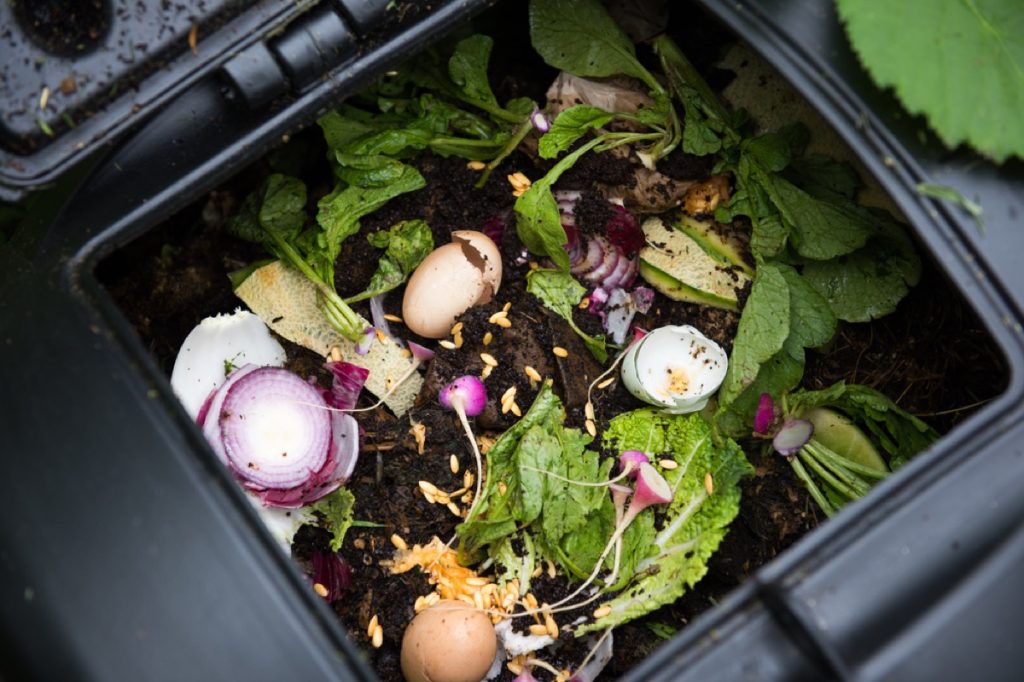
Whether you’ve kept a bin in your kitchen for years or are just getting into it, composting is a remarkably simple and effective way to use items you’d normally throw away to your benefit. You can think of it as a process used to “recycle” organic materials, such as food scraps and grass clippings, says Kate Colarulli, head of strategic insights at CleanChoice Energy.
“Combining organic matter in a compost pile or compost bin allows it to decompose, creating a nutrient-rich compost that can be added to soil to enrich it,” she explains.
What Is Compost Used For?
If you’ve ever struggled to get your garden going at the beginning of the season, composting could be an easy solution to your problems. Compost can come from a wide range of materials, but basically, it’s an organic fertilizer that “can be used to enrich soil, promoting plant growth and biodiversity,” says Lauren Click, founder of Let’s Go Compost.
That’s because finished compost consists of organic raw materials that are carbon- or nitrogen-based that are great for your garden.
“Carbon-rich materials include dead leaves, woody branches, sawdust, cardboard, or pine needles,” Janet Loughrey of Garden Design tells Best Life. “Nitrogen-rich materials include fresh grass clippings, green plant trimmings, livestock manure, kitchen scraps, egg shells, and coffee grounds.”
Typically, the process of turning this organic waste into finished compost takes six to nine months. “People use compost to amend soil and grow stronger, healthier plants,” says Click. “New plants then become delicious food people, pollinators, or animals can eat.”
RELATED: 13 Low-Maintenance Outdoor Plants for Beginners.
How Does Compost Benefit the Environment?
Learning how to make compost can have immediate benefits for your garden and lawn, but the pros don’t end there. It’s also an eco-friendly habit that can help the planet in the long run.
Besides reducing the need for synthetic fertilizers, Click says that it also helps combat food waste—which is responsible for a large percentage of global greenhouse gas emissions like methane. “And methane emissions are 28 percent more potent than carbon emissions,” she adds.
Composting also helps sequester carbon in the soil, improve soil structure, and reduce water runoff, which can strip it of vital nutrients for growth. At the same time, it also provides a rich source of essential nutrients, including nitrogen, phosphorus, and potassium.
“Its organic matter improves soil structure, water retention, and nutrient availability, fostering a healthier environment for plant growth,” Click explains. “The neutral to slightly acidic pH of compost helps regulate soil pH levels, further optimizing nutrient uptake by crops. And it supports pollinator populations through enhanced biodiversity within the soil and minimizing chemical exposure.”
“It also creates a closed-loop system by converting waste into valuable compost, which can then be used for agricultural purposes. This aligns with the principles of a circular economy,” she adds.
What Types of Compost Exist?
While finished compost is typically seen as one finished organic product, its starting components include two different sets of types known as green and brown materials.
“Green materials, which provide nitrogen-rich materials, include items such as fruit and vegetable scraps, fresh grass clippings, coffee grounds, tea leaves, flowers, corn cobs, and garden waste,” explains Colarulli. “Brown materials, which provide carbon-rich materials, include materials such as dry leaves, branches, twigs, fresh grass clippings, straw and hay, shredded paper, egg shells, and woodchips.”
However, just because it’s been through your kitchen doesn’t mean it should end up in your traditional compost pile. Certain items should be left out, including meat or meat bones, fish and fish scraps, dairy, oils and grease, pet waste, coated or shiny paper, chemically treated yard waste, plastic, metal, and glass, says Colarulli.
To utilize some of these materials, you can try another process, however.
“Unlike other methods, Bokashi composting allows for meats, fats, and oils that can’t go in most compost bins,” says Lauren Gropper, founder and CEO at Repurpose. “It requires added materials to spark fermentation, but only takes 10 to 14 days to convert organic materials into usable soil.”
RELATED: 5 Plants That Will Keep Mosquitoes Out of Your Yard, According to Pest Experts.
How to Make Compost
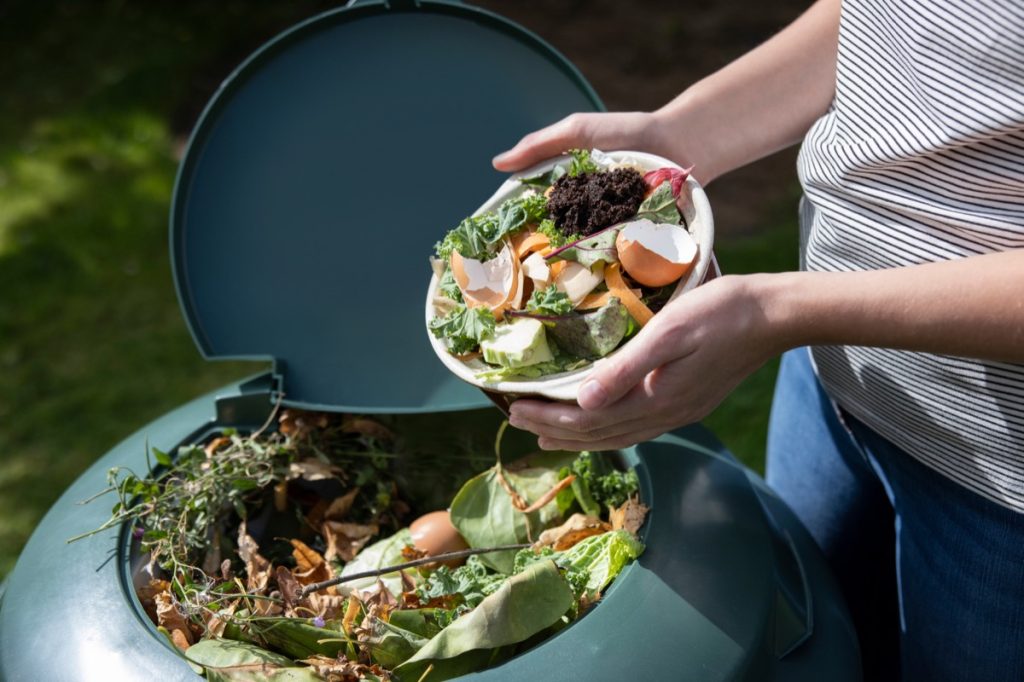
Even if you don’t have a yard or garden to fertilize, composting for the planet’s sake can be a worthwhile endeavor. Your options will vary, however, depending on your living situation.
In urban environments with no outdoor space
Those living in city apartments or other spaces without a yard or outdoor space are essentially left with one choice.
“The only indoor composting option is using a vermicomposter—also known as a worm bin,” says Colarulli. “This bin takes up little space, is relatively easy to maintain, and produces no odor if maintained properly.”
Urbanites can purchase a ready-made vermicomposter or opt to make their own. “With a worm bin, you can collect the compost every few months and use it to nourish indoor plants.”
Lack the counter space to compost indoors? “Here’s a green hack: Freeze your food scraps and carbon-rich material in a compostable bin bag and drop them off at your convenience at a pile or service near you that accepts them,” says Gropper.
In urban or suburban environments with little outdoor space
If you’re fortunate to have even a tiny bit of outdoor space, such as a patio or balcony, there’s another choice available to you.
“In this case, you can use either a worm bin or a compost tumbler, which is a bit bigger than a worm bin and is kept outside,” says Colarulli. “Compost tumblers make it easy to turn and mix the compost while also protecting it from animals and speeding up the composting process. There are several compost tumbler options available for purchase, or you can build your own.”
In suburban or rural environments with plenty of outdoor space
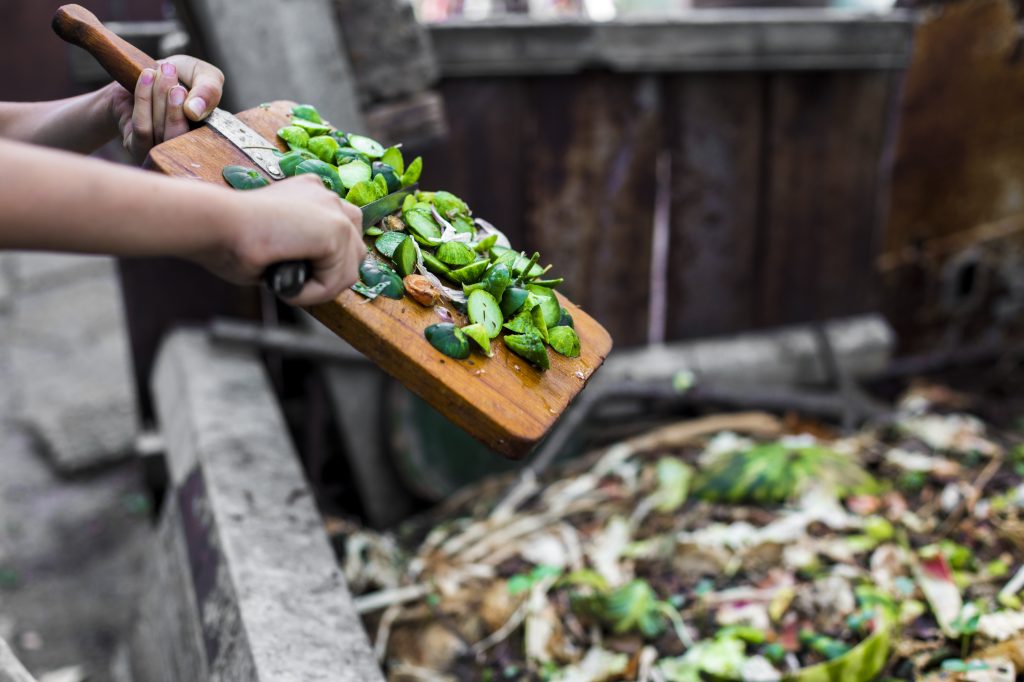
Those who have the advantage of plenty of outdoor space have the most composting options to choose from.
“You can use a worm bin, a compost tumbler, a larger enclosed bin in your yard, or a combination of the three,” says Colarulli. “As with the other bins, there are many enclosed bin options available for purchase, or you can make your own. If you compost with an outdoor bin, you can also purchase a smaller bin for your kitchen where you can place your scraps until you’re ready to take them out to the outdoor compost bin and cut down on work.”
And while the traditional composting process can turn around finished material in months, there are other outdoor techniques that use more of a hands-off approach.
“Cold composting is a slower, less labor-intensive method of composting where organic materials are added to a pile and left to decompose naturally over time without frequent turning,” says Reese L. Robbins, founder of Just Pure Gardening. “This method takes longer, often a year, but requires minimal effort.”
This system is typically ideal for those who want to repurpose large amounts of grass clippings or fallen leaves but also still incorporate food waste from their kitchen.
RELATED: The Best Natural Insecticides to Help Save Your Garden.
Drop-off or pickup services
Looking to contribute but don’t want to set up a system of your own? Click suggests reaching out to a community garden to see if they collect scraps or yard waste.
Some areas also have curbside pickup services from local initiatives or farmers who can take your scraps off your hands on a weekly or monthly basis.
“Often, a local farmer will collect food scraps via interchangeable buckets on a set basis. The food scraps are then used as animal feed or are used in compost piles on their farm,” Click says.
The best part? All this requires is setting up a small collection bin in your kitchen or storing your scraps in a freezer until it’s time to hand them off. Unsure of where to find someone willing to take them? She suggests using online directories such as ShareWaste to get started.
Other composting options
It’s not just households that are getting behind the benefits of composting: Larger institutions are beginning to pitch in, sometimes with the help of municipal governments. However, Click warns that these industrial, commercial, and large-scale specialized facilities that can compost large volumes of organic waste are still just getting started.
“Many of these programs are not yet available,” she says. “Only four percent of Americans have access to an industrial composting facility, which is what’s needed to compost bioplastics and most ‘compostable’ plastic packaging materials sold in all 50 states.”
How to Choose a Compost Bin
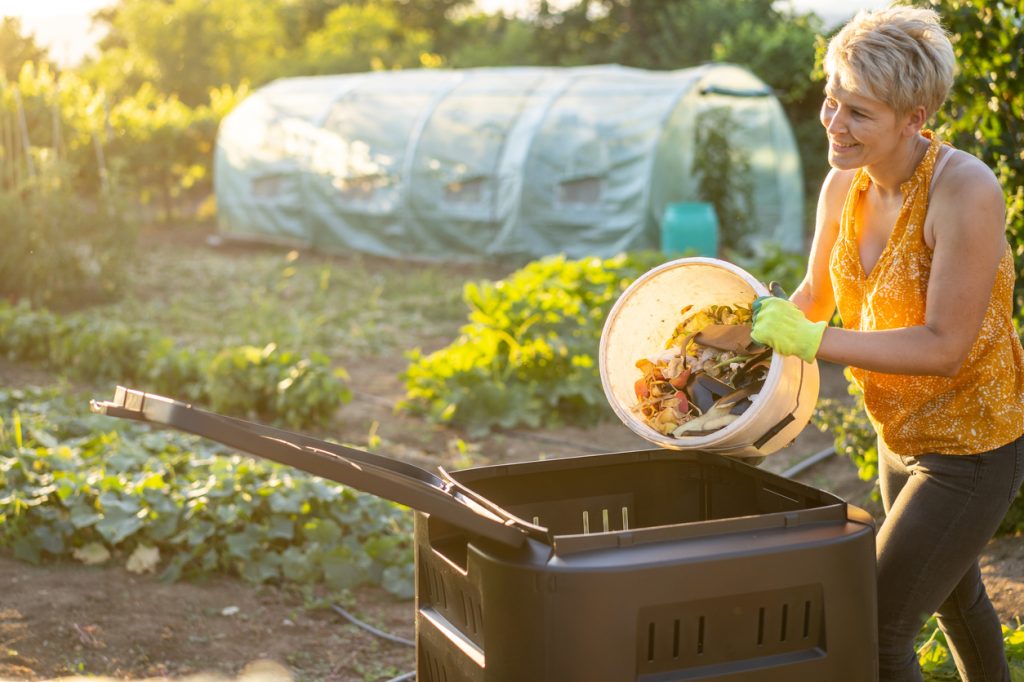
Depending on your level of commitment and living situation, there’s clearly not a one-size-fits-all solution when it comes to picking out a compost bin. Instead, there are many options you can consider depending on your lifestyle and what works best for you.
“You can invest in a composting roller or tumbler that stores your compostable scraps and rolls your organic materials to save space and initiate the decomposition process,” says Gropper. “Depending on your budget, you could also consider a home composter, like the Lomi home composting machine, which breaks down your organics into rich soil.”
Whether you’re considering building your own or buying one that’s ready-made, Robbins suggests you choose the size that can handle the amount of scraps you produce but is still small enough to manage easily. It’s also important to consider which material it’s made of, with plastic, wood, and metal all coming with their own benefits and drawbacks related to cost, insulation, and durability over time. However, one element must always be considered.
“Good airflow is crucial for aerobic decomposition,” Robbins says. “Look for bins with good ventilation.”
RELATED: Gardening Influencer Reveals the #1 Plant to Give Your Yard Beautiful Color.
Compost vs. Fertilizer: What’s the Difference?
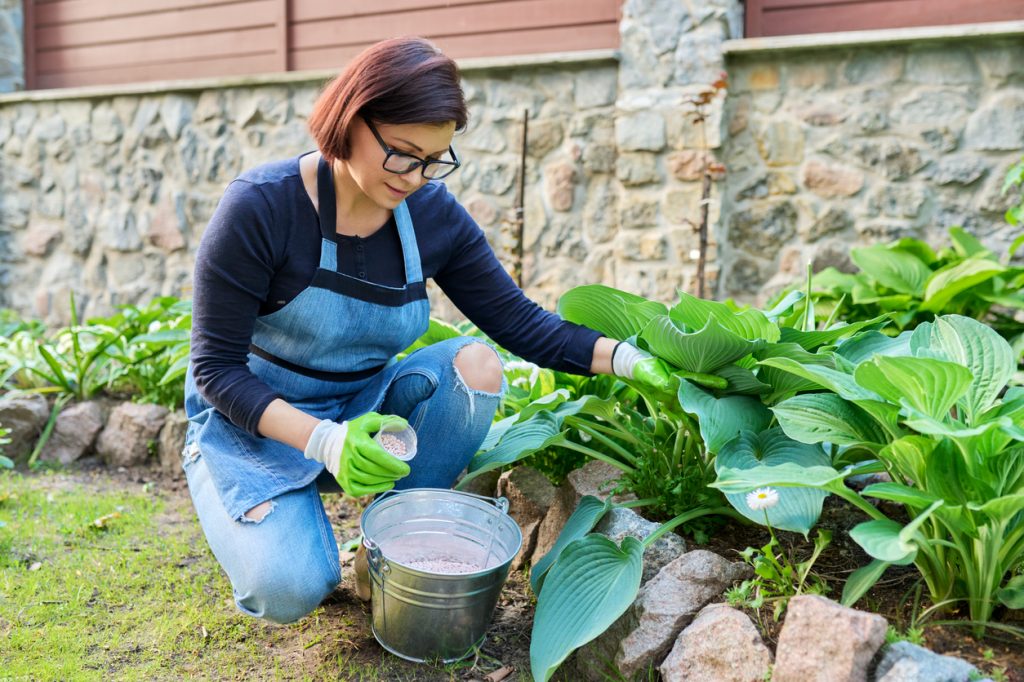
Anyone who’s tried their hand at gardening has probably purchased a bag of commercial fertilizer from their local supply store in hopes of spurring some growth. But while both can help your plants, they’re far from equal when it comes to their effects on the environment.
“Remember: Compost is an organic fertilizer,” says Click. “Traditional chemical fertilizers create nitrogen runoff into local water supplies and groundwater, in addition to the immense amount of electricity needed to produce it. Additionally, when mixed with other garden chemicals, chemical fertilizers can create fumes and pollute waterways, soil, and the air, like when you mix a bit of fertilizer into an area treated with chemical pesticides.”
Overall, this can make homemade compost a much more eco-friendly option for your yard work purposes.
Conclusion
No matter what your level of commitment is, starting to compost can yield multiple benefits with relatively minimal effort. It helps create nitrogen-rich and carbon-rich material that makes for a perfect organic fertilizer for your garden, eliminating the need for potentially harmful commercial products made with chemicals. It also helps the planet by reducing the amount of methane-producing food waste going to landfills and returning nutrients to the soil to help sustain eco-diversity.
Ultimately, there’s a way to get into composting no matter where you live or how much space you’re working with. Simply consider all of the options and make the choice that’s best for you, whether it’s building a large bin in your backyard or saving up scraps in your freezer to drop off at a nearby collection point.